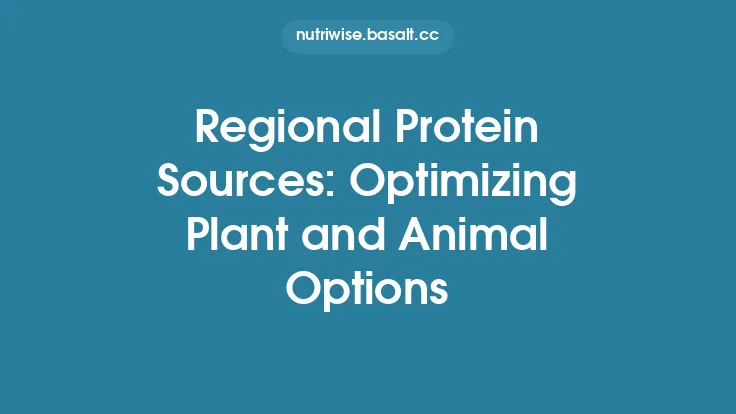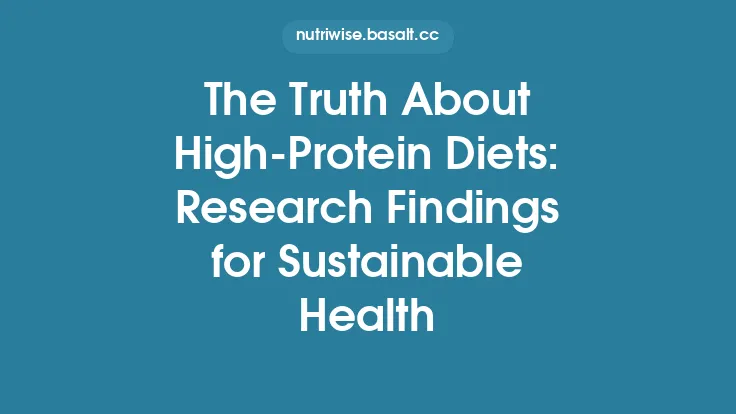Protein is the building block of every cell in the human body, playing a central role in muscle repair, enzyme production, hormone synthesis, and immune function. While the total amount of protein consumed matters, the *quality* of that protein—how well it supplies the essential amino acids our bodies cannot make—has a profound impact on health outcomes, athletic performance, and long‑term disease risk. In recent years, the conversation has shifted from “how much protein?” to “what kind of protein?” as consumers, clinicians, and researchers compare plant‑derived sources (such as legumes, nuts, seeds, and grains) with animal‑derived sources (including meat, dairy, eggs, and fish). This article delves into the scientific criteria that define protein quality, examines the strengths and limitations of both plant and animal options, and offers practical guidance for selecting high‑quality protein that aligns with individual goals, dietary preferences, and physiological needs.
Defining Protein Quality: Amino Acid Completeness and Digestibility
Essential Amino Acids (EAAs). Humans require nine essential amino acids—histidine, isoleucine, leucine, lysine, methionine (and its derivative cysteine), phenylalanine (and tyrosine), threonine, tryptophan, and valine—because the body cannot synthesize them. A protein source is considered *complete* when it supplies all nine EAAs in proportions that meet or exceed human requirements.
Digestibility and Bioavailability. Even a protein that contains all EAAs can be of limited value if it is poorly digested. Digestibility refers to the proportion of ingested protein that is broken down into absorbable amino acids in the gastrointestinal tract. Bioavailability further accounts for the extent to which those amino acids are utilized for protein synthesis after absorption.
Standardized Scoring Systems.
- PDCAAS (Protein Digestibility‑Corrected Amino Acid Score). Developed by the FAO/WHO, PDCAAS compares the amino acid profile of a test protein to a reference pattern (based on human requirements) and multiplies by its digestibility (measured by fecal nitrogen loss). Scores range from 0 to 1.0, with 1.0 indicating a protein that meets or exceeds the reference pattern.
- DIAAS (Digestible Indispensable Amino Acid Score). A newer method that measures digestibility at the end of the small intestine (ileal digestibility) rather than fecal loss, providing a more accurate reflection of amino acid absorption. DIAAS also uses a reference pattern but can exceed 1.0, highlighting proteins that surpass human needs.
Both scores are useful tools, but DIAAS is increasingly favored for research because it avoids overestimation caused by microbial fermentation in the colon.
Animal‑Based Proteins: High Scores, High Bioavailability
| Source | PDCAAS | DIAAS | Notable EAAs | Typical Serving (g) |
|---|---|---|---|---|
| Whey (concentrate) | 1.00 | 1.12 | Leucine‑rich, high lysine | 30 g |
| Egg white | 1.00 | 1.10 | Balanced EAAs, high sulfur AAs | 50 g |
| Beef (lean) | 0.92 | 1.00 | High methionine, lysine | 85 g |
| Chicken breast | 0.92 | 0.99 | High lysine, threonine | 85 g |
| Fish (salmon) | 0.92 | 0.98 | Rich in leucine, methionine | 85 g |
| Dairy (Greek yogurt) | 1.00 | 1.05 | High calcium‑binding casein | 170 g |
Key Advantages
- Complete Amino Acid Profiles. Most animal proteins naturally contain all EAAs in ratios that meet or exceed the reference pattern, making them “complete” without the need for complementary foods.
- High Digestibility. The protein matrix in animal tissues is generally more accessible to digestive enzymes, resulting in PDCAAS and DIAAS values close to or at 1.0.
- Leucine Density. Leucine is a potent activator of the mTOR pathway, which stimulates muscle protein synthesis (MPS). Animal proteins, especially whey, are particularly rich in leucine, a benefit for athletes and older adults seeking to preserve lean mass.
- Micronutrient Synergy. While outside the scope of this article, animal proteins often co‑occur with bioavailable iron (heme), vitamin B12, zinc, and omega‑3 fatty acids, which can indirectly support protein metabolism.
Considerations and Limitations
- Saturated Fat and Cholesterol. Certain animal cuts contain higher levels of saturated fatty acids and cholesterol, which may influence cardiovascular risk when consumed in excess.
- Environmental Footprint. Production of livestock protein generally requires more land, water, and energy than plant protein, a factor for sustainability‑focused consumers (though not the primary focus here).
- Allergies and Intolerances. Dairy and egg proteins can trigger allergic reactions or intolerances in susceptible individuals.
Plant‑Based Proteins: Diversity, Complementarity, and Emerging Quality Metrics
| Source | PDCAAS | DIAAS | Notable EAAs | Typical Serving (g) |
|---|---|---|---|---|
| Soy isolate | 0.99 | 1.00 | High lysine, balanced profile | 30 g |
| Pea protein concentrate | 0.89 | 0.93 | Good lysine, moderate methionine | 30 g |
| Hemp seed | 0.55 | 0.61 | Rich in arginine, moderate lysine | 30 g |
| Lentils (cooked) | 0.52 | 0.58 | High lysine, low methionine | 100 g |
| Quinoa (cooked) | 0.78 | 0.84 | Complete, higher methionine than most grains | 185 g |
| Chickpeas (cooked) | 0.71 | 0.77 | High lysine, low methionine | 100 g |
Key Advantages
- Complete Plant Proteins Exist. Soy, quinoa, and amaranth naturally provide all EAAs in adequate proportions, achieving PDCAAS and DIAAS scores comparable to many animal proteins.
- Low Saturated Fat, No Cholesterol. Plant proteins are inherently free of dietary cholesterol and contain minimal saturated fat, supporting cardiovascular health when part of a balanced diet.
- Fiber and Phytochemicals. The protein matrix in legumes, seeds, and whole grains is accompanied by dietary fiber, antioxidants, and polyphenols, which can improve gut health and reduce inflammation.
- Flexibility for Dietary Patterns. Plant proteins align with vegetarian, vegan, and flexitarian eating styles, making them accessible to a wide range of cultural and ethical preferences.
Challenges Specific to Plant Proteins
- Amino Acid Imbalance. Most plant proteins are limited in one or more EAAs. For example, legumes are typically low in methionine, while grains are low in lysine. This “limiting amino acid” concept necessitates strategic food combinations (e.g., rice + beans) to achieve a complete profile.
- Lower Digestibility. Plant cell walls contain cellulose, hemicellulose, and lignin, which can impede enzyme access. Anti‑nutrients such as phytates, tannins, and protease inhibitors further reduce protein digestibility. Processing methods—soaking, sprouting, fermenting, and cooking—can markedly improve both digestibility and bioavailability.
- Variable Protein Concentration. Whole plant foods often contain a lower percentage of protein per gram compared with animal foods, requiring larger portion sizes or concentrated isolates (e.g., soy or pea protein powders) to meet high protein targets.
The Role of Anti‑Nutrients and Processing in Plant Protein Quality
Phytates (Phytic Acid). Found primarily in seeds, legumes, and whole grains, phytates chelate minerals (iron, zinc, calcium) and can bind to proteins, reducing enzymatic hydrolysis. Soaking beans for 8–12 hours, discarding the soaking water, and cooking can reduce phytate content by up to 50 %.
Protease Inhibitors. Compounds such as trypsin inhibitors in soy and lectins in beans interfere with protein digestion. Heat treatment (boiling, pressure cooking) denatures these inhibitors, enhancing protein digestibility.
Tannins and Polyphenols. While beneficial antioxidants, high concentrations can precipitate proteins and diminish absorption. Fermentation (e.g., tempeh, miso) breaks down tannins and increases the availability of amino acids.
Processing Techniques that Boost Quality
| Technique | Effect on Protein Quality |
|---|---|
| Sprouting | Increases enzyme activity, reduces anti‑nutrients, modestly raises protein digestibility (5‑10 %). |
| Fermentation | Breaks down complex proteins into peptides, improves DIAAS scores (e.g., tempeh’s DIAAS ≈ 0.90). |
| Extrusion (for isolates) | Produces high‑purity protein powders with PDCAAS ≈ 1.0, but may denature heat‑sensitive amino acids if not controlled. |
| Roasting | Enhances flavor and reduces moisture, but excessive heat can cause Maillard reactions that bind lysine, lowering its availability. |
Understanding these processing impacts allows consumers to select plant protein products that have been optimized for digestibility and amino acid retention.
Matching Protein Quality to Physiological Needs
1. Athletes and Strength‑Focused Individuals
- Leucine Threshold. Research suggests that ~2.5 g of leucine per meal maximally stimulates MPS. Whey protein (≈ 10 % leucine) reaches this threshold with ~25 g of protein, whereas soy or pea protein may require 30–35 g.
- Timing and Distribution. Consuming 0.4–0.55 g protein · kg⁻¹ body weight per meal across 3–4 meals aligns with the leucine threshold for most adults.
- Supplementation Options. For vegans, blended plant protein powders (e.g., pea + rice) can achieve a leucine content comparable to whey when formulated at ≥ 20 % leucine.
2. Older Adults (≥ 65 years)
- Anabolic Resistance. Aging blunts the MPS response, necessitating higher protein intake (1.2–1.5 g · kg⁻¹ day⁻¹) and greater leucine per meal (≈ 3 g).
- Digestibility Concerns. Age‑related reductions in gastric acid and pancreatic enzymes make highly digestible proteins (e.g., whey, egg, or hydrolyzed soy) advantageous.
- Practical Strategies. Incorporating dairy (Greek yogurt, cottage cheese) or fortified plant‑based yogurts can provide both high‑quality protein and calcium.
3. Pregnant and Lactating Women
- Increased Requirements. Protein needs rise by ~25 % (≈ 1.1 g · kg⁻¹ day⁻¹). Complete proteins are essential to support fetal growth.
- Micronutrient Synergy. Animal proteins supply bioavailable iron and B12, which are critical during pregnancy; plant‑based diets should include fortified foods or supplements.
4. Individuals with Renal Considerations
- Protein Quantity vs. Quality. For those on protein‑restricted regimens, selecting high‑quality proteins ensures essential amino acid needs are met with lower total intake.
- Plant‑Based Advantage. Plant proteins often have a lower net acid load, potentially easing renal stress, but must be combined to avoid limiting amino acids.
Practical Guidelines for Building a High‑Quality Protein Portfolio
- Prioritize Complete Sources. Include at least one complete protein daily—e.g., eggs, dairy, fish, soy, quinoa, or a well‑formulated plant blend.
- Use Complementary Pairings. When relying on single plant foods, pair lysine‑rich legumes with methionine‑rich grains (e.g., lentil soup with brown rice) to achieve a complete amino acid profile.
- Leverage Fortified Products. Many plant milks, yogurts, and meat analogs are fortified with B12, vitamin D, and calcium, bridging gaps that may otherwise arise.
- Mind Portion Sizes. To meet higher protein targets, consider concentrated sources (protein powders, isolates) while monitoring overall caloric intake.
- Mind Cooking Methods. Opt for gentle steaming, pressure cooking, or fermentation to preserve heat‑sensitive amino acids (e.g., lysine) and reduce anti‑nutrients.
- Track Leucine Intake. For muscle‑focused goals, aim for 2.5–3 g leucine per main meal; adjust portion sizes of plant proteins accordingly.
- Rotate Protein Sources. Variety reduces the risk of nutrient deficiencies and provides a broader spectrum of bioactive peptides.
Emerging Research and Future Directions
- DIAAS Adoption. As more laboratories adopt ileal digestibility measurements, we will gain a clearer picture of the true protein quality of novel plant isolates (e.g., fava bean, lupin) and alternative animal proteins (e.g., insect, cultured meat).
- Peptide Bioactivity. Beyond amino acid composition, specific protein‑derived peptides exhibit antihypertensive, antioxidant, and immunomodulatory properties. Ongoing studies aim to identify processing methods that preserve or enhance these bioactive sequences.
- Personalized Nutrition. Genomic and metabolomic profiling may soon allow clinicians to tailor protein recommendations based on individual variations in muscle protein synthesis signaling, gut microbiome composition, and amino acid metabolism.
- Hybrid Products. The market is seeing an influx of “hybrid” protein powders that blend animal (e.g., whey) and plant (e.g., pea) proteins, seeking to combine the high leucine density of whey with the sustainability and allergen‑friendly nature of plant proteins.
Bottom Line
Choosing high‑quality protein is less about labeling a food as “plant” or “animal” and more about evaluating completeness, digestibility, and amino acid density in the context of one’s personal health goals. Animal proteins generally deliver the highest PDCAAS/DIAAS scores with minimal processing, making them reliable sources for athletes, older adults, and individuals with increased protein needs. Plant proteins, when selected wisely—favoring complete sources like soy and quinoa, employing complementary pairings, and utilizing processing techniques that reduce anti‑nutrients—can meet or exceed the quality of many animal options while offering additional benefits such as lower saturated fat, fiber, and phytochemicals.
By understanding the science behind protein quality and applying practical strategies—balancing complete and complementary sources, optimizing preparation methods, and aligning intake with physiological demands—consumers can construct a protein portfolio that supports muscle health, metabolic function, and overall well‑being, regardless of dietary preference.





